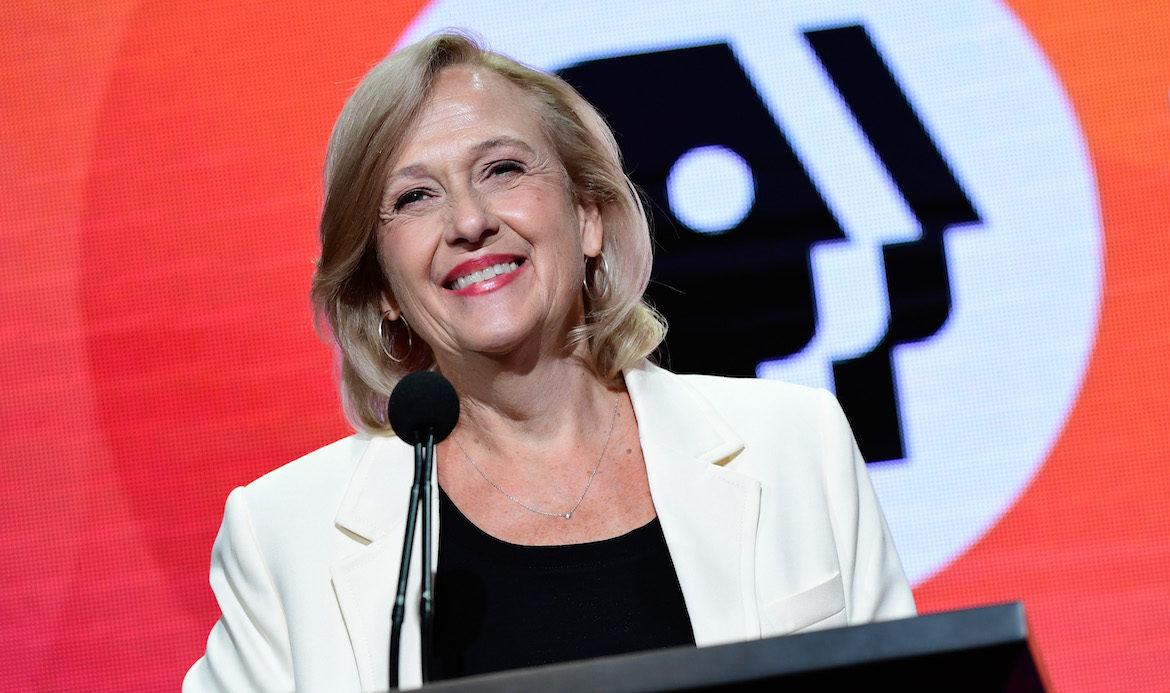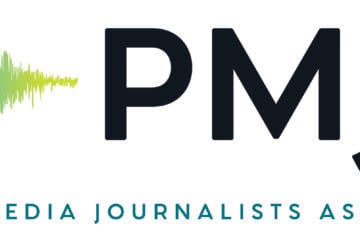PBS wrestles with ‘profound transformation’ into multiplatform organization

Rahoul Ghose / PBS
PBS' Paula Kerger discussed plans to expand public TV's digital footprint during TCA's 2019 Summer Press Tour.
A couple of weeks after PBS President Paula Kerger spoke at the 2022 Television Critics Association’s virtual Summer Press Tour, she talked with Current about what’s going on behind the scenes at PBS.
In this Q&A, an edited version of her conversation with TV critic Jacqueline Cutler, Kerger describes the structure she created at PBS for diversity, equity and inclusion initiatives, and how viewers’ migration to streaming platforms is changing PBS’ role as a distributor.
Current: Over the last few press tours, there’s been a fair amount of talk about ensuring diversity in PBS projects. [Chief Programming Executive] Sylvia Bugg has said PBS is investing in a new generation of diverse filmmakers. Where does this stand?
Paula Kerger: These last couple of years have been a moment for everybody to step back and say, “We’ve done good work, but are we really doing everything that we can?” Clearly, there are areas where we should be looking harder.
We’re set up as a federated organization. I don’t have a newsroom. I don’t have people producing within PBS. All of our relationships are second- and thirdhand. To really dig down under the hood and get an understanding of what those productions look like depends on information we didn’t always have access to. That’s what Sylvia has been working to figure out.
A year ago, we decided to create a position, senior vice president of diversity equity and inclusion, that reports directly to me. This isn’t the first time we’ve had a position like this. What I didn’t want to do is bring someone in and then park them in an office near mine — which is actually where Sylvia is, right across the hall from my office — without also putting a structure around her. I also put together an executive council for her; it’s not just me on it, but also Sylvia; Sara DeWitt, who runs kids programming; Mike Jacobson, who runs HR; Katherine Lauderdale, who in addition to being our general counsel does board-related work; and Jim Dunford, who does all our station-facing work.
We meet on a monthly basis with Cecilia [Loving, senior VP of DEI at PBS] and give her not only support but help push her work out beyond her office. Board development is crucial, too, and I work closely with our general counsel on that. Our board is diverse, but it’s something you have to continually work on. I think of it like gardening — how you continue to make the garden that much more vibrant and so forth.
Another piece that’s interesting is station relations. Some of our stations are small organizations, and some are much bigger, and we’re all really interested in figuring out what they should be doing within their own communities. Some of the bigger ones have hired their own DEI people. You need to make sure that we’re not tripping over each other. If we can make the operationalizing of it more efficient, then we’ll be able to take a snapshot at any given time and not only have a sense of who’s doing what but also really learn from each other.
We are continuing to talk about how to collect better data because metrics are important. We have this sort of love-hate relationship with metrics because we can look at the same audience measurements as Netflix, ABC, CBS or whatever; that tells one little piece of the story. I care if we do a show and more than 12 people watch, right? Just because we do something that’s popular doesn’t mean that meets our mission.
That’s why I always feel kind of like an outlier on stage [at TCA] because we use the same tools, but we’re not exactly in the same business. Trying to measure impact — that’s the harder piece. So you try to survey people — how did this affect you? You look at awards — that’s a good proxy. But really measuring if you’re making progress and not just feeling good about something — that’s a challenge. For a public service media organization, those are the questions I really want to get to.
Current: With PBS being about three years into its over-the-top streaming deal with YouTube TV, how well has it worked so far to build viewers and membership for stations?
Kerger: We are in the midst of what is a pretty profound transformation, and this is what we are wrestling with as we think about our next strategic plan. Obviously, it’s embedded in the current work we have going forward.
We’re a broadcast organization; we always have been. Many of the decisions we make are really driven that way — you have the broadcast, and then you sort of build out around it. But if you look at audience, how our audience is engaging with us, more and more people are going to the PBS Video app, YouTube TV and all the other places we’re distributing content. We saw that first with kids. They were going to the app, they were playing games online, they were going to YouTube — all these other spaces. And now we’re seeing that with general audience programming. We are still broadcasters — and we’re pretty passionate about that — but for a lot of people this is how they get public broadcasting content.
We tend to think that everybody’s got connections to all the streamers and everything — not the case. Some of it’s economic; some of it [is geographic]. My house is in the western part of Virginia, and if I go five miles north there is no broadband. If I go five miles south, there isn’t much broadband. There are lots of places where the infrastructure wasn’t built out. So broadcast is still important to people. But it is no longer the principal driver of everything. As we continue to build out our infrastructure, it becomes more of another component.
For those that gather data, it feels like [streaming is how] a larger and larger percentage of people are accessing information. It’s not just the younger people; you’re now seeing a wave of older audiences watching on free, advertiser-supported channels, on YouTube, the Netflixes and the Amazons and everything else. As we go through this period where it feels like everything became much more fractured — I do think it’s just going to be sloppy while people adjust and readjust.
From our perspective, what’s important is being in those digital spaces, making sure that we have a robust presence on the [PBS Video] app. It’s on, I think, now 85 or 90% of all smart TVs, which is where a lot of people do get content. You can watch on YouTube TV, and then you can watch [on] all these other places.
Current: Are there plans to renew that contract?
Kerger: The YouTube deal is an ongoing deal.
Current: Are deals with other over-the-top streaming companies already in place?
Kerger: We’re on other platforms and continue to look for new places where we can offer live linear streams. Right now, our principal distribution is through the app, which a lot of stations are promoting. Our stations have Passport, their Netflix-like service, which is a member benefit. And we have the YouTube TV [deal], which our stations for the most part all participate in. That’s the priorities right now.
Current: PBS’ revenue budget for this year includes $20 million dollars in designated funds, a significant portion of which came from the long-term investment portfolio. Have the revenue projections in your budget been affected by volatility in the stock market?
Kerger: Those assets were set aside. But we have an investment portfolio like any other company that we’re continuing to monitor, and we’ve had some really good years. This year so far has been a little bumpier. But it’s not impacted the investment that we’ll be able to make in our budget.
Current: What are the biggest challenges that PBS is facing?
Kerger: You can put this into three buckets, and they’re big ones. One is that we’re trying to figure out where and how we bring our stations along in this multiplatform environment, and [how] we share our content together in spaces that people can access. We began as a single channel that we put up on the air, and then that was distributed through cable. Now we’ve come to the point where we’ve got lots of options. So first, it’s figuring out distribution and, alongside that, the discovery question, which is, how do you make sure that people find those channels and find that content? That’s why TCA is important, because you just want to make sure that you’re producing great content that will be of great interest to people.
The second piece is making sure that we are developing strong content with a range of content creators. A lot of our content comes directly from stations; some of it comes from other relationships. Making sure that pipeline is robust and meets the needs and interests of the people we serve, that’s profoundly important. In fact, I could have started with that.
The third challenge always is revenue. As we look at this multiplatform environment, how do we make sure that we — meaning PBS and stations — have resources to be able to deliver the services the community is looking for? My guess is, as we move more and more to multiplatform, that may continue to shift. It may look different than in the days when everything really rode on our fundraising drive.
For example, I was watching something on one of the digital platforms and a QR code popped up. I could see very easily popping in a QR code and making a donation. So you might be watching Frontline, and thinking you want to contribute to more investigative journalism, and then that code pops up, at the end. That provides a whole other way that you can develop a relationship with people who really love your content.
In terms of revenue, membership is a piece; major donor philanthropy is a piece. Some of our stations do events; some get state money. We get a little bit of federal money that’s leveraged by stations. There’s lots of ways that people bring resources, and all of that together enables the work that we’re trying to do.
Those three buckets all have interesting pieces within them that we have to pay attention to.
This moment that we’re in, as everything transforms, the thing is — what does it mean for PBS to truly be a multiplatform organization? We need to make sure we’re structured in a way that we’re [providing] lots of different feeds, and that we’ve got the infrastructure in place to be able to support all of that, including the Passport service and everything else. It requires a lot of thought to make sure that we’re organized to do it as effectively and efficiently as we can. And we will.
Jacqueline Cutler, a veteran journalist with extensive experience in entertainment reporting, has written about PBS for many news organizations. She is VP of the Television Critics Association.
Correction: This interview has been updated to correct a transcription error. Kerger described older viewers migrating to “free, advertiser-supported channels,” not free “sporting channels.”







(Amazon). It’s nice to be able to watch live TV from a station’s website and possibly the app. Anyone with an antenna can watch PBS for free (in most cases). Do you think it’s a plus for YouTube TV reach? Additionally, PBS needs to place content on OTT platforms such Pluto TV and FreeVee. What about an ad-supported version of the app if ads are not on it?
I thing I always thought was the ineffective marketing of PBS programming outside of the PBS Realm. I do not believe I have seen any promotional marketing for shows on other platforms. With many of the shows I believe more people would watch.
Fred,
Re: having the local station be part of You Tube TV: Yes, it is essential that we be swimming in the streaming pool where our competitors and the viewers hang out. As people are exiting cable in droves, and as over-the-air is a hassle to switch over to if most of your viewing is via streaming (or cable), we must be available on a stream, too. I chose You Tube TV for my home because they carry PBS stations — and I rejected Fubo, Sling, Philo, and Hulu because they don’t.